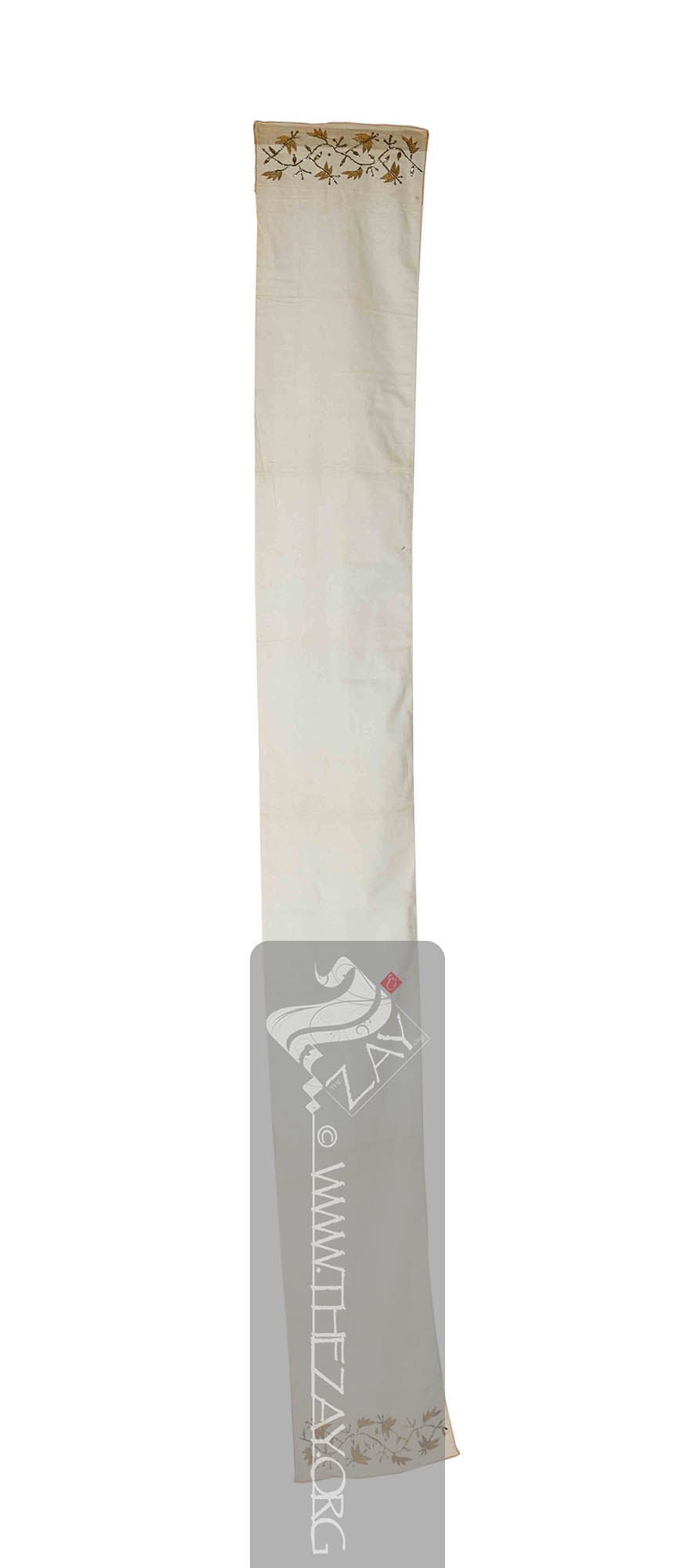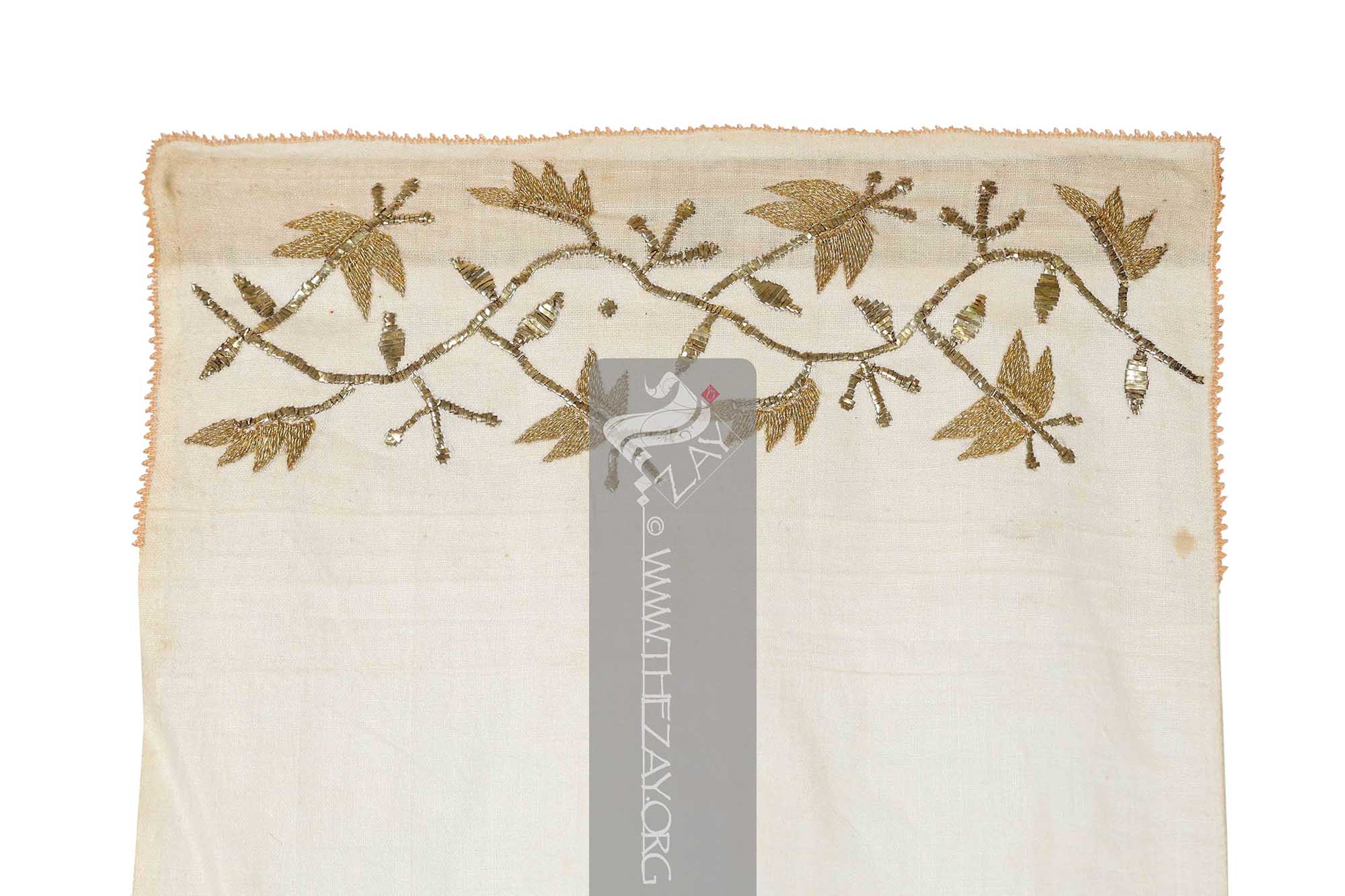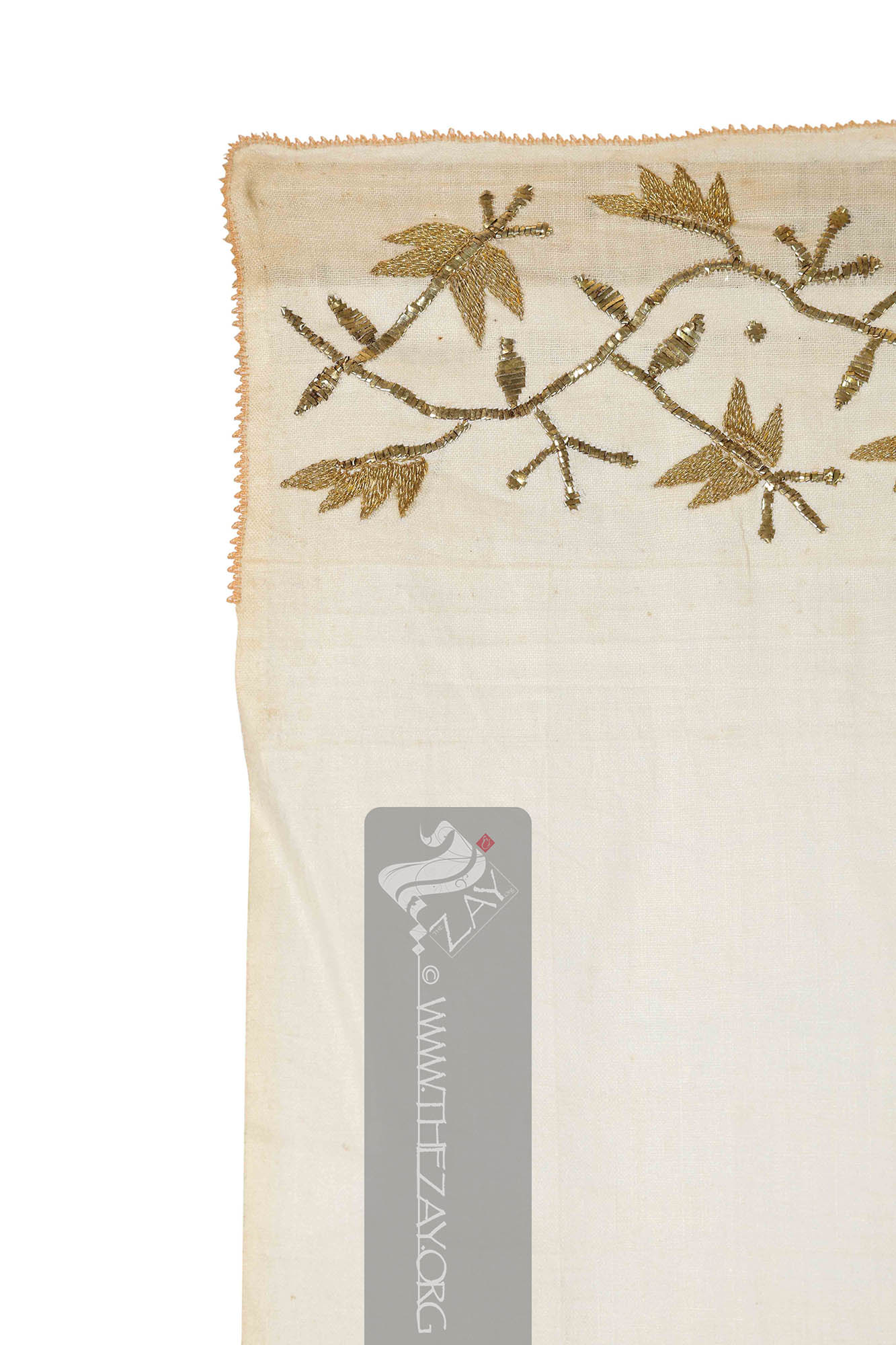






| Local Name | Yaglik |
| Object Category | Accessory |
| Gender | Unisex |
| Place Of orgin | Asia |
| Region | Turkey |
| Object Range | Turkey, Syria, Iraq, Lebanon, Kuwait, Palestine, Jordan, Saudi Arabia, Egypt, Sudan, Cyprus, Bulgaria, Romania, Moldova, Greece, North Macedonia, Croatia, Serbia, Bosnia Herzegovina, Kosovo, Armenia, Azerbaijan, Georgia, et al. |
| Dimensions | Length: 22 cm Width: 137 cm |
| Materials | Cotton Metal |
| Technique | Hand Embroidered Machine Stitched Crochet |
| Motif | Floral |
| Provenance | Purchased, Dealer, New York 2022 |
| Location | The Zay Zay: (Arabic: costume, Pl. azyaā’), a set of clothes in a style typical of a particular country or historical period. Initiative |
| Status | In Storage |
| ZI number | ZI2022.501009.5 ASIA |
Object Note
Part of a lot with nine more items also in the collection (ZI2022.501009.1 SYRIA, ZI2022.501009.2 MOROCCO, ZI2022.501009.3 AFRICA, ZI2022.501009.4 AFRICA, ZI2022.501009.6 ASIA, and ZI2022.501009.7 ASIA, ZI2022.501009.8 YEMEN, ZI2022.501009.9 YEMEN, ZI2022.501009.10 YEMEN).
Object History
This piece of garment was purchased by Dr. Reem Tariq
Ṭariq: (Arabic; Synonym: tulle_bi_talli
Tūlle_bi_tallī: (French: Tulle – a city in France where fine material for veil was first made; Turkish: tel – wire; Synonym: tariq; talli; badla; khus_dozi ), series of small metal knots made on a woven net ground as embellishment. The term is commonly used in the North African Arab region specifically in Egypt. Ṭariq: (Arabic; Synonym: tulle_bi_talli
Tūlle_bi_tallī: (French: Tulle – a city in France where fine material for veil was first made; Turkish: tel – wire; Synonym: tariq; talli; badla; khus_dozi ), series of small metal knots made on a woven net ground as embellishment. The term is commonly used in the North African Arab region specifically in Egypt.
Object Features
This is a rectangular ivory cotton (muslin Muslin: (Arabic: Mosul – A city in Iraq, or French: Mousse – Foam; Synonym: Mulmul; Melmel), a fine variety of plain-woven cotton unique to the Gangetic Delta – Ganges, Padma, and Meghna rivers. The term is either a derivative of Mosul, where it exchanged hands or "mousse" due to its lightweight and fluffy texture. ) towel (yaglik Yaglik: (Proto Turkic: yaglik – kerchief, head scarf), an embroidered textile, traditionally rectangular in shape, used for household decoration or special occasions. Originally referring to napkins made of cotton or linen, it evolved to include ornate embroidery, particularly favoured by young brides in their trousseau. ) with one (weft Weft: one of the two basic components used in weaving that transforms thread or yarns into a piece of fabric. It is the crosswise thread on a loom that is passed over and under the warp threads.) end featuring a picot hem while the other a (selvedge Selvedge: (English: Self-finished edge or self-edge: a dialect forming transition), an edge produced on woven fabric during manufacture that prevents it from unravelling. Traditionally the term selvage applied to only loom woven fabric, presently it could be applied to flat knitted fabric too. ) end and (warp Warp: One of the two basic components used in weaving which transforms thread or yarns to a piece of fabric. The warp is the set of yarns stretched longitudinally in place on a loom before the weft Weft: one of the two basic components used in weaving that transforms thread or yarns into a piece of fabric. It is the crosswise thread on a loom that is passed over and under the warp threads. is introduced during the weaving process. ) ends featuring metal thread (sirma Sirma: (Byzantine Greek: súrma – a dragging motion, from Ancient Greek: súrō – to draw; Synonym: Tel_sirma Tel_sirma: (Ottoman Turkish: tel – wire, thread, chord; Byzantine Greek: súrma – a dragging motion from Ancient Greek: súrō – to draw; Synonym: Sirma), a metal lace or thread traditionally made of silver or gold and sometimes even copper often used textile embellishments such as embroidery and weaves like brocades. ), a metal lace or thread traditionally made of silver or gold and sometimes even copper often used textile embellishments such as embroidery and weaves like brocades. )/(tel_sirma Tel_sirma: (Ottoman Turkish: tel – wire, thread, chord; Byzantine Greek: súrma – a dragging motion from Ancient Greek: súrō – to draw; Synonym: Sirma), a metal lace or thread traditionally made of silver or gold and sometimes even copper often used textile embellishments such as embroidery and weaves like brocades. ) – gold – embroidered embellishment.
The field of the piece is plain while the warp Warp: One of the two basic components used in weaving which transforms thread or yarns to a piece of fabric. The warp is the set of yarns stretched longitudinally in place on a loom before the weft Weft: one of the two basic components used in weaving that transforms thread or yarns into a piece of fabric. It is the crosswise thread on a loom that is passed over and under the warp threads. is introduced during the weaving process. ends feature embellished floral and foliage patterns with gold sirma Sirma: (Byzantine Greek: súrma – a dragging motion, from Ancient Greek: súrō – to draw; Synonym: Tel_sirma Tel_sirma: (Ottoman Turkish: tel – wire, thread, chord; Byzantine Greek: súrma – a dragging motion from Ancient Greek: súrō – to draw; Synonym: Sirma), a metal lace or thread traditionally made of silver or gold and sometimes even copper often used textile embellishments such as embroidery and weaves like brocades. ), a metal lace or thread traditionally made of silver or gold and sometimes even copper often used textile embellishments such as embroidery and weaves like brocades. . A central wavy vine made with gold foils is flanked with gold sirma Sirma: (Byzantine Greek: súrma – a dragging motion, from Ancient Greek: súrō – to draw; Synonym: Tel_sirma Tel_sirma: (Ottoman Turkish: tel – wire, thread, chord; Byzantine Greek: súrma – a dragging motion from Ancient Greek: súrō – to draw; Synonym: Sirma), a metal lace or thread traditionally made of silver or gold and sometimes even copper often used textile embellishments such as embroidery and weaves like brocades. ), a metal lace or thread traditionally made of silver or gold and sometimes even copper often used textile embellishments such as embroidery and weaves like brocades. embroidered in (blanket_stitch Blanket_stitch: A basic sewing stitch used to secure the edges of fabric or create decorative borders by looping the thread over the edges of blankets, quilts, and other fabrics and pulling it through, forming a series of evenly spaced stitches that resemble a chain. ) style. The ends of the fabric are folded and stitched to give it a clean look and an extremely thin peach-pink needle lace (oya Oyā: (Turkish), refers to various forms of narrow needle lace trimmings common to eastern and southern Mediterranean regions and parts of Armenia. Believed to be a derivative of Venetian lace it is considered an indelible part of the traditional craft of Türkiye today. ) trimming is attached at the end.
During the late Ottoman period, especially from c. 18th century, such elaborately done yaglik
Yaglik: (Proto Turkic: yaglik – kerchief, head scarf), an embroidered textile, traditionally rectangular in shape, used for household decoration or special occasions. Originally referring to napkins made of cotton or linen, it evolved to include ornate embroidery, particularly favoured by young brides in their trousseau. would often be used as a waist band (kusak
Kusak: (Turkish), a wide belt, sash or girdle worn around the waist to secure clothing. Typically made of fabric, leather, or embroidered material, it serves both practical and decorative purposes by adding a touch of elegance to traditional Ottoman attire. ) too, over a pair of loose trousers (shalvar
shalvār: in Farsi, in the Emirati colloquial: ṣarwāl. In the Levantine colloquial: Shirwāl. Plural: sarāwīl, ṣarāwīl, sharāwīl, ṣarwīlāt). It is loose pants at the waist with folds, and narrow at the ankles. It is tied with a rope at the waist.) and undershirt (gömlek
Gömlek: (Proto-Turkic: köyŋelek – Shirt; Azerbaijani: köynək – Shirt; Turkmen: koynek
Koynek: A traditional long, loose-fitting tunic or dress worn by Turkmen women in Central Asia typically made of silk or cotton, adorned with intricate embroidery, and often characterized by vibrant colours and geometric patterns. It is cultural symbol of significant importance reflecting the artistic heritage of Turkmen people. – long loose tunic dress), a traditional calf-length sleeved undershirt or tunic generally made of a plain white cotton, silk, or linen fabric, some more lightweight than others, worn by both Ottoman men and women of all communities throughout the empire.
More Info
In Turkish parlance, the term yaglik Yaglik: (Proto Turkic: yaglik – kerchief, head scarf), an embroidered textile, traditionally rectangular in shape, used for household decoration or special occasions. Originally referring to napkins made of cotton or linen, it evolved to include ornate embroidery, particularly favoured by young brides in their trousseau. originally denoted a rectangular piece of cotton or linen, available in various sizes, used primarily as a napkin. Often, both ends of the yaglik Yaglik: (Proto Turkic: yaglik – kerchief, head scarf), an embroidered textile, traditionally rectangular in shape, used for household decoration or special occasions. Originally referring to napkins made of cotton or linen, it evolved to include ornate embroidery, particularly favoured by young brides in their trousseau. were embellished with embroidery.
Over time, the term expanded in meaning to encompass embroidered textiles used for decorative purposes within the household or during special occasions.
Young brides frequently included yaglik Yaglik: (Proto Turkic: yaglik – kerchief, head scarf), an embroidered textile, traditionally rectangular in shape, used for household decoration or special occasions. Originally referring to napkins made of cotton or linen, it evolved to include ornate embroidery, particularly favoured by young brides in their trousseau. that was endearingly crafted by themselves and other members of their family in their trousseau as cherished possessions.
However, sashes with embroidery perhaps were not as important prior to the 18th century as embroidery in Ottoman Turkey until then, primarily emulated the luxurious woven silks and velvets found in courtly textiles.
Ottoman embroidery began to be recognised as an independent art form only after the first quarter of the 18th century when it deviated from the replication of woven designs and embraced a more creative approach. This shift allowed for the inclusion of new and naturalistic floral motifs that flowed more freely across the design field.
Simultaneously, an examination of historical artworks from Iran reveals a progressive evolution in the style of waist girdles which eventually evolved into an Ottoman kusak Kusak: (Turkish), a wide belt, sash or girdle worn around the waist to secure clothing. Typically made of fabric, leather, or embroidered material, it serves both practical and decorative purposes by adding a touch of elegance to traditional Ottoman attire. . During the early 16th century, it was customary for individuals in Iran to wear a leather strap adorned with metal plaques. Subsequently, this design gave way to a narrower textile band fastened with gold clasps.
Thomas Herbert, a member of an English embassy to Iran in the late 1620s, made noteworthy observations regarding the length of these sashes and the significant variations in their materials. According to him individuals of different social statuses distinguished themselves through the quality of their band and the accompanying plain, but opulent fabric towels used underneath them.
These fabrics were often made of silk and gold for nobilities, while the merchants wore them woven with silver, and lower-ranking individuals wore them in silk and wool.
Similar sashes were also prevalent in the realms, adjacent to the Safavid cultural sphere – Ottoman and Mughal. By the late 17th century, this fashion trend had not just been widely accepted in the Ottoman Empire but transcended beyond it. It had reached parts of eastern Europe, such as Poland and Russia.
Thus, the courtiers in these regions embraced the use of textiles and fashion trends imported from Ottoman Turkey as status symbols. While the style of dress amongst the aristocracy in this region as well as the Ottoman empire gradually started drawing inspiration from the West, the popularity of the sash endured as an indelible mark of Ottoman influence either as an elaborate buckled kusak Kusak: (Turkish), a wide belt, sash or girdle worn around the waist to secure clothing. Typically made of fabric, leather, or embroidered material, it serves both practical and decorative purposes by adding a touch of elegance to traditional Ottoman attire. or as an daintily embroidered yaglik Yaglik: (Proto Turkic: yaglik – kerchief, head scarf), an embroidered textile, traditionally rectangular in shape, used for household decoration or special occasions. Originally referring to napkins made of cotton or linen, it evolved to include ornate embroidery, particularly favoured by young brides in their trousseau. .
Links